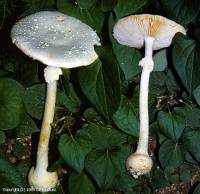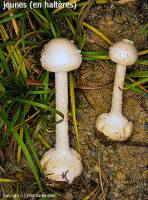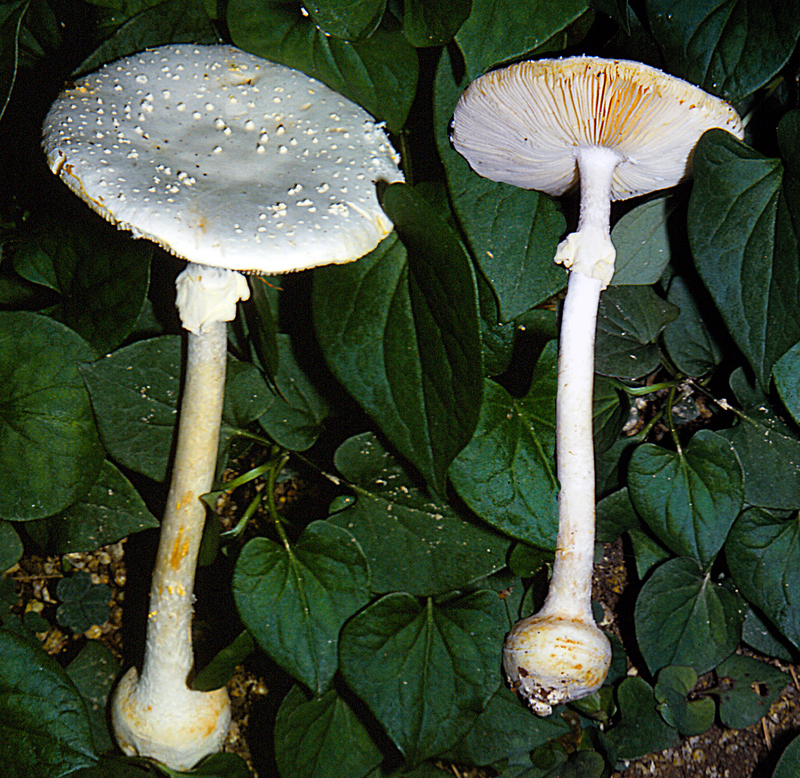Amanite à bulbe sphérique, démon blanc bulbeux (タマシロオニタケ)
 |
 |
Basidiomycota / Agaricomycetes / Agaricales / Amanitaceae.
Amanita abrupta Peck (1897) , Bulletin of the Torrey botanical Club, 24(3), p. 138 (Basionyme) (nom actuel)
Lepiota abrupta (Peck) E.-J. Gilbert & Kühner (1928) , Bulletin de la Société mycologique de France, 44, p. 151
Aspidella abrupta (Peck) E.-J. Gilbert (1940) , Iconographia mycologica, 27, supplément 1(1), p. 79
Amanita sphaerobulbosa Hongo (1969), Journal of Japanese Botany 44, p. 230
- Chapeau : 3-8 cm, sphérique puis étalé, orné de nombreuses petites verrues coniques très détersiles.
- Chair blanche, à odeur rance, de terre désagréable.
- Spores subglobuleuses 7-8,5 µm, amyloïdes.
- Habitat : Peu fréquent en été et en début d'automne en forêts de feuillus, mycorhizes fréquentes avec les Fagacées; Amérique du Nord orientale, Japon : Fagus. (hêtres), Betula (bouleaux), Abies (sapin), Tsuga , Quercus (chênes), Pinus. (pins) et Populus (peupliers).
- Comestibilité Toxique
- Références bibliographiques : IH1 229 ; IOH p. 169 ; Bibliographie de Jacques Trimbach
- Confusions possibles
Amanita virgineoides, a des épines sur le chapeau, est plus charnue et a un bulbe moins abrupt.
Amanita japonica, est plus charnue, possède un bulbe moins abrupt et possède de nombreuses petites épines détachables sur le chapeau.
Amanita sphaerobulbosa, possède ded dpores plus étroites, de nombreuses hyphes et cellules enflées et réfringentes, surtout dans le voile du chapeau.
- Commentaires : les jeunes spécimens ressemblent à de petites haltères.
Dernière modification : 21/09/2018 - Daniel Guez
Amanita sphaerobulbosa, commonly known as the Asian abrupt-bulbed Lepidella, is a species of agaric fungus in the family Amanitaceae. First described by mycologist Tsuguo Hongo in 1969,[1] it is found in Southern Asia. The species was formerly consider synonymous with the North American lookalike Amanita abrupta, but that species has narrower spores, a persistent partial veil, and lacks the refractive contents found in the hyphae and inflated cells of A. sphaerobulbosa.[2]
The fruit bodies of Amanita sphaerobulbosa are damaging to the liver; the toxicity is thought to be largely due to a rare amino acid. Although not considered as toxic as its infamous relatives the death cap and the destroying angel, A. sphaerobulbosa is blamed for the deaths of two Japanese women in 1978. Poisoning symptoms included the abrupt appearance of violent vomiting, diarrhea and dehydration after a delay of 10–20 hours.






/http%3A%2F%2Fstorage.canalblog.com%2F13%2F20%2F1309869%2F121720217_o.jpg)
/http%3A%2F%2Fstorage.canalblog.com%2F09%2F49%2F1309869%2F102512115_o.jpg)
/http%3A%2F%2Fstorage.canalblog.com%2F31%2F84%2F1309869%2F102512113_o.jpg)
/http%3A%2F%2Fstorage.canalblog.com%2F68%2F50%2F1309869%2F122910444_o.jpg)